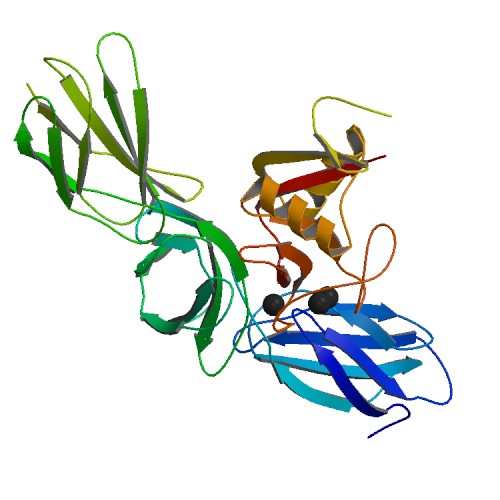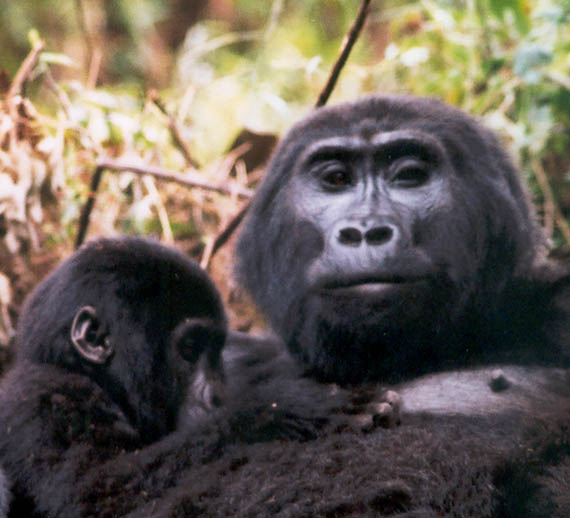|
Versican
Versican is a large extracellular matrix proteoglycan that is present in a variety of human tissues. It is encoded by the ''VCAN'' gene. Versican is a large chondroitin sulfate proteoglycan with an apparent molecular mass of more than 1000kDa. In 1989, Zimmermann and Ruoslahti cloned and sequenced the core protein of fibroblast chondroitin sulfate proteoglycan. They designated it versican in recognition of its versatile modular structure. Versican belongs to the lectican protein family, with aggrecan (abundant in cartilage), brevican and neurocan (nervous system proteoglycans) as other members. Versican is also known as chondroitin sulfate proteoglycan core protein 2 or chondroitin sulfate proteoglycan 2 (CSPG2), and PG-M. Structure These proteoglycans share a homology (biology), homologous globular N-terminal, C-terminal, and glycosaminoglycan (GAG) binding regions. The N-terminal (G1) globular domain consists of Antibody, Ig-like loop and two link modules, and has Hyalur ... [...More Info...] [...Related Items...] OR: [Wikipedia] [Google] [Baidu] |
Chondroitin Sulfate Proteoglycan
Chondroitin sulfate proteoglycans (CSPGs) are proteoglycans consisting of a protein core and a chondroitin sulfate side chain. They are known to be structural components of a variety of human tissues, including cartilage, and also play key roles in neural development and glial scar formation. They are known to be involved in certain cell processes, such as cell adhesion, cell growth, receptor binding, cell migration, and interaction with other extracellular matrix constituents. They are also known to interact with laminin, fibronectin, tenascin, and collagen. CSPGs are generally secreted from cells. Importantly, CSPGs are known to inhibit axon regeneration after spinal cord injury. CSPGs contribute to glial scar formation post injury, acting as a barrier against new axons growing into the injury site. CSPGs play a crucial role in explaining why the spinal cord doesn't self-regenerate after an injury. General structure Chondroitin sulfate proteoglycans are composed of a core protei ... [...More Info...] [...Related Items...] OR: [Wikipedia] [Google] [Baidu] |
Perineuronal Net
Perineuronal nets (PNNs) are specialized extracellular matrix structures responsible for synaptic stabilization in the adult brain. PNNs are found around certain neuron cell bodies and proximal neurites in the central nervous system. PNNs play a critical role in the closure of the childhood critical period, and their digestion can cause restored critical period-like synaptic plasticity in the adult brain. They are largely negatively charged and composed of chondroitin sulfate proteoglycans, molecules that play a key role in development and plasticity during postnatal development and in the adult. PNNs appear to be mainly present in the cortex, hippocampus, thalamus, brainstem, and the spinal cord. Studies of the rat brain have shown that the cortex contains high numbers of PNNs in the motor and primary sensory areas and relatively fewer in the association and limbic cortices. In the cortex, PNNs are associated mostly with inhibitory interneurons and are thought to be respo ... [...More Info...] [...Related Items...] OR: [Wikipedia] [Google] [Baidu] |
Lectican
Lecticans, also known as hyalectans, are a family of large chondroitin sulfate proteoglycans found in the extracellular matrix. There are four members of the lectican family: aggrecan, brevican, neurocan, and versican. Lecticans interact with hyaluronic acid and tenascin-R to form a ternary complex. Tissue distribution Aggregan and versican are widely distributed throughout all tissues. Where aggrecan is a major extracellular matrix constituent in cartilage, versican is widely expressed in a number of connective tissues, including those in vascular smooth muscle, skin, and the cells of central and peripheral nervous systems. Brevican and neurocan are primarily restricted to the central nervous system (CNS) and are particularly abundant in perineuronal nets. Structure All four lecticans contain an N-terminal globular domain (G1 domain) that in turn contains an immunoglobulin V-set domain and a Link domain that binds hyaluronic acid; a long extended central domain (CS) that is mod ... [...More Info...] [...Related Items...] OR: [Wikipedia] [Google] [Baidu] |
Proteoglycan
Proteoglycans are proteins that are heavily glycosylated. The basic proteoglycan unit consists of a "core protein" with one or more covalently attached glycosaminoglycan (GAG) chain(s). The point of attachment is a serine (Ser) residue to which the glycosaminoglycan is joined through a tetrasaccharide bridge (e.g. chondroitin sulfate- GlcA- Gal-Gal- Xyl-PROTEIN). The Ser residue is generally in the sequence -Ser- Gly-X-Gly- (where X can be any amino acid residue but proline), although not every protein with this sequence has an attached glycosaminoglycan. The chains are long, linear carbohydrate polymers that are negatively charged under physiological conditions due to the occurrence of sulfate and uronic acid groups. Proteoglycans occur in connective tissue. Types Proteoglycans are categorized by their relative size (large and small) and the nature of their glycosaminoglycan chains. Types include: Certain members are considered members of the "small leucine-rich pr ... [...More Info...] [...Related Items...] OR: [Wikipedia] [Google] [Baidu] |
Aggrecan
Aggrecan (ACAN), also known as cartilage-specific proteoglycan core protein (CSPCP) or chondroitin sulfate proteoglycan 1, is a protein that in humans is encoded by the ''ACAN'' gene. This gene is a member of the lectican ( chondroitin sulfate proteoglycan) family. The encoded protein is an integral part of the extracellular matrix in cartilagenous tissue and it withstands compression in cartilage. Aggrecan is a proteoglycan, or a protein modified with large carbohydrates; the human form of the protein is 2316 amino acids long and can be expressed in multiple isoforms due to alternative splicing. Aggrecan was named for its ability to form large aggregates in the cartilage tissue (a large aggregating proteoglycan). Structure Aggrecan is a high molecular weight ( molar mass between 1 million and 3 million) proteoglycan. It exhibits a bottlebrush structure, in which chondroitin sulfate and keratan sulfate glycosaminoglycan (GAG) chains are attached to an extended protein ... [...More Info...] [...Related Items...] OR: [Wikipedia] [Google] [Baidu] |
Lewis Lung Carcinoma
''Lewis lung carcinoma is a hypermutated Kras/Nras–mutant cancer with extensive regional mutation clusters in its genome. A tumor that spontaneously developed as an epidermoid carcinoma in the lung of a C57BL mouse. It was discovered in 1951 by Dr. Margaret Lewis of the Wistar Institute and became one of the first transplantable tumors. Thirty-three deleterious mutations are present in 30 cancer genes including Kras, Nras, Trp53, Dcc, and Cacna1d. Cdkn2a and Cdkn2b are biallelically deleted from the genome. Five pathways (RTK/RAS, p53, cell cycle, TGFB, and Hippo) are oncogenically deregulated or affected. The major mutational processes in LLC include chromosomal instability, exposure to metabolic mutagens, spontaneous 5–methylcytosine deamination, defective DNA mismatch repair, and reactive oxygen species. Our data also suggest that LLC is a lung cancer similar to human lung adenocarcinoma. Models Syngeneic According to a 2015 review article, Lewis lung carcinoma is t ... [...More Info...] [...Related Items...] OR: [Wikipedia] [Google] [Baidu] |
Breast
The breasts are two prominences located on the upper ventral region of the torso among humans and other primates. Both sexes develop breasts from the same embryology, embryological tissues. The relative size and development of the breasts is a major secondary sex distinction between females and males. There is also considerable Bra size, variation in size between individuals. Permanent Breast development, breast growth during puberty is caused by estrogens in conjunction with the growth hormone. Female humans are the only mammals that permanently develop breasts at puberty; all other mammals develop their mammary tissue during the latter period of pregnancy. In females, the breast serves as the mammary gland, which produces and secretes milk to feed infants. Subcutaneous fat covers and envelops a network of lactiferous duct, ducts that converge on the nipple, and these tissue (biology), tissues give the breast its distinct size and globular shape. At the ends of the ducts are ... [...More Info...] [...Related Items...] OR: [Wikipedia] [Google] [Baidu] |
TLR2
Toll-like receptor 2 also known as TLR2 is a protein that in humans is encoded by the ''TLR2'' gene. TLR2 has also been designated as CD282 (cluster of differentiation 282). TLR2 is one of the toll-like receptors and plays a role in the immune system. TLR2 is a membrane protein, a receptor, which is expressed on the surface of certain cells and recognizes foreign substances and passes on appropriate signals to the cells of the immune system. Function The protein encoded by this gene is a member of the toll-like receptor (TLR) family, which plays a fundamental role in pathogen recognition and activation of innate immunity. TLRs are highly conserved from ''Drosophila'' to humans and share structural and functional similarities. They recognize pathogen-associated molecular patterns (PAMPs) that are expressed on infectious agents, and mediate the production of cytokines necessary for the development of effective immunity. The various TLRs exhibit different patterns of expression. T ... [...More Info...] [...Related Items...] OR: [Wikipedia] [Google] [Baidu] |
Carbohydrate-binding Module
In molecular biology, a carbohydrate-binding module (CBM) is a protein domain found in carbohydrate-active enzymes (for example glycoside hydrolases). The majority of these domains have carbohydrate-binding activity. Some of these domains are found on cellulosomal scaffoldin proteins. CBMs were previously known as cellulose-binding domains. CBMs are classified into numerous families, based on amino acid sequence similarity. There are currently (June 2011) 64 families of CBM in the CAZy database. CBMs of microbial glycoside hydrolases play a central role in the recycling of photosynthetically fixed carbon through their binding to specific plant structural polysaccharides. CBMs can recognise both crystalline and amorphous cellulose forms. CBMs are the most common non-catalytic modules associated with enzymes active in plant cell-wall hydrolysis. Many putative CBMs have been identified by amino acid sequence alignments but only a few representatives have been s ... [...More Info...] [...Related Items...] OR: [Wikipedia] [Google] [Baidu] |
Sarcoma
A sarcoma is a rare type of cancer that arises from cells of mesenchymal origin. Originating from mesenchymal cells means that sarcomas are cancers of connective tissues such as bone, cartilage, muscle, fat, or vascular tissues. Sarcomas are one of five different types of cancer, classified by the cell type from which they originate. While there are five types under this category, sarcomas are most frequently contrasted with carcinomas which are much more common. Sarcomas are quite rare, making up about 1% of all adult cancer diagnoses and 15% of childhood cancer diagnoses. There are many subtypes of sarcoma, which are classified based on the specific tissue and type of cell from which the tumor originates. Common examples of sarcoma include liposarcoma, leiomyosarcoma, and osteosarcoma. Sarcomas are ''primary'' connective tissue tumors, meaning that they arise in connective tissues. This is in contrast to ''secondary'' (or " metastatic") connective tissue tumors, ... [...More Info...] [...Related Items...] OR: [Wikipedia] [Google] [Baidu] |
Melanoma
Melanoma is the most dangerous type of skin cancer; it develops from the melanin-producing cells known as melanocytes. It typically occurs in the skin, but may rarely occur in the mouth, intestines, or eye (uveal melanoma). In very rare cases melanoma can also happen in the lung which is known as primary pulmonary melanoma and only happens in 0.01% of primary lung tumors. In women, melanomas most commonly occur on the legs; while in men, on the back. Melanoma is frequently referred to as malignant melanoma. However, the medical community stresses that there is no such thing as a 'benign melanoma' and recommends that the term 'malignant melanoma' should be avoided as redundant. About 25% of melanomas develop from nevus, moles. Changes in a mole that can indicate melanoma include increaseespecially rapid increasein size, irregular edges, change in color, itchiness, or nevus#Classification, skin breakdown. The primary cause of melanoma is ultraviolet light (UV) exposure in th ... [...More Info...] [...Related Items...] OR: [Wikipedia] [Google] [Baidu] |


